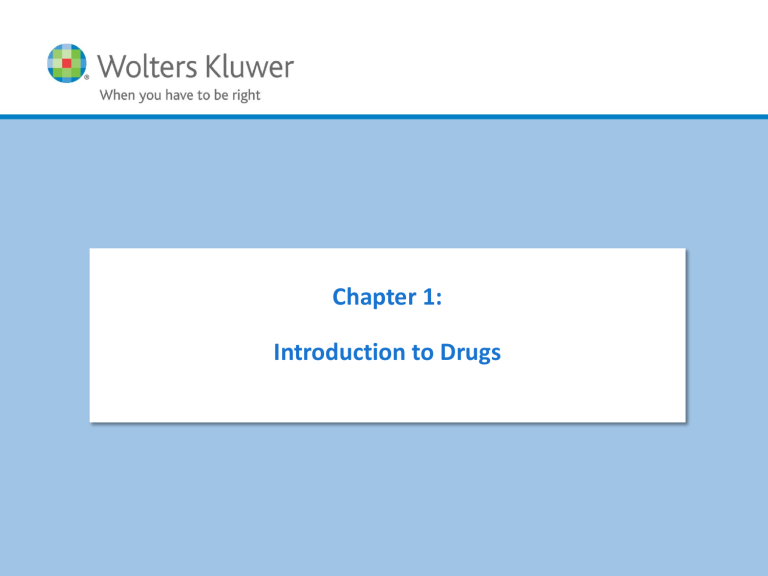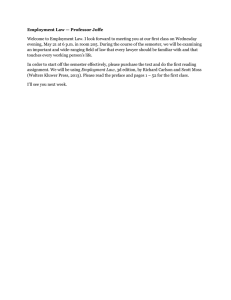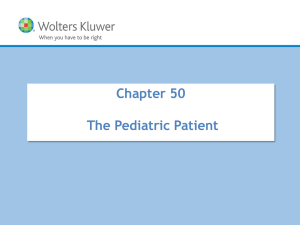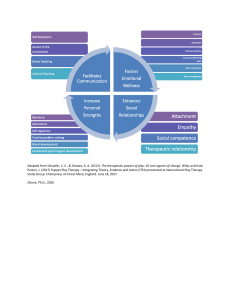
Chapter 1: Introduction to Drugs Copyright Copyright © 2013 Wolters © 2017 Wolters Kluwer Health Kluwer| •Lippincott All RightsWilliams Reserved & Wilkins Pharmacology • Pharmacology is the study of the biological effects of chemicals. • Drugs are chemicals that are introduced into the body to cause some sort of change. • Health care providers focus on how chemicals act on living organisms. • Nurses deal with pharmacotherapeutics, or clinical pharmacology. • Some drug effects are therapeutic, or helpful, but others are undesirable or potentially dangerous (adverse effects) Copyright © 2017 Wolters Kluwer • All Rights Reserved Nurse’s Responsibility • Administering drug • Assessing drug effects • Intervening to make the drug regimen more tolerable • Providing patient teachings about drugs and the drug regimen • Monitoring the overall patient care plan to prevent medication errors Copyright © 2017 Wolters Kluwer • All Rights Reserved Sources of Drugs • Natural Sources • Plants • Synthetic version of the active chemical found in a plant • Main component of the growing alternative therapy movement Copyright © 2017 Wolters Kluwer • All Rights Reserved Drug examples : Plants Copyright © 2017 Wolters Kluwer • All Rights Reserved Sources of Drugs (cont.) • Natural Sources (cont.) • Animal products • Used to replace human chemicals that are not produced because of disease or genetic problems • Genetic engineering • Many of these preparations are now created synthetically Copyright © 2017 Wolters Kluwer • All Rights Reserved Sources of Drugs (cont.) • Natural Sources (cont.) • Inorganic compounds • Salts of various elements can have therapeutic effects in the human body • Synthetic Sources • Genetic engineering alter bacteria to produce chemicals that are therapeutic and effective • Original prototypes Copyright © 2017 Wolters Kluwer • All Rights Reserved Drug examples :Inorganic Copyright © 2017 Wolters Kluwer • All Rights Reserved Drug Evaluation • Preclinical Trials • Chemicals tested on laboratory animals • Phase I Studies • Chemicals tested on human volunteers • Phase II Studies • Drug tried on informed patients with the disease • Phase III Studies • Drug used in vast clinical market • Phase IV Studies • Continual evaluation of the drug Copyright © 2017 Wolters Kluwer • All Rights Reserved Question Tell whether the following statement is true or false. Groups of similar drugs, all of which are derived from an original prototype, are available today because of technological advances that make a particular drug more desirable in a specific situation. Copyright © 2017 Wolters Kluwer • All Rights Reserved Answer True Rationale: These technological advances have led to the development of groups of similar drugs, all of which are derived from an original prototype, but each of which has slightly different properties, making a particular drug more desirable in a specific situation. Copyright © 2017 Wolters Kluwer • All Rights Reserved Legislation Copyright © 2017 Wolters Kluwer • All Rights Reserved Pregnancy Categories Copyright © 2017 Wolters Kluwer • All Rights Reserved Controlled Substances • The Controlled Substances Act of 1970 • Control over the coding of drugs and the enforcement of these codes to the FDA and the Drug Enforcement Agency (DEA), a part of the U.S. Department of Justice. • Prescription, distribution, storage, and use of these drugs are closely monitored. • Local policies and procedures might be even more rigorous. Copyright © 2017 Wolters Kluwer • All Rights Reserved Controlled Substances (cont.) Copyright © 2017 Wolters Kluwer • All Rights Reserved Generic Drugs • Chemicals that are produced by companies involved solely in the manufacturing of drugs • Bioavailability of the drug • “Dispensed as written” • Important in drugs that have narrow safety margins Copyright © 2017 Wolters Kluwer • All Rights Reserved Orphan Drugs • Drugs that have been discovered, but are not financially viable and therefore have not been “adopted” by any drug company • The Orphan Drug Act of 1983 Copyright © 2017 Wolters Kluwer • All Rights Reserved Over-the-Counter Drugs • Products that are available without prescription for self-treatment of a variety of complaints. • Some of these agents were approved as prescription drugs. • Later were found to be very safe and useful for patients (example: loratidine). • Many of these drugs were “grandfathered.” Copyright © 2017 Wolters Kluwer • All Rights Reserved Over-the-Counter Drugs (cont.) • Nurses should consider several problems related to OTC drug use: • Taking these drugs could mask the signs and symptoms of underlying disease, making diagnosis difficult. • Taking these drugs with prescription medications could result in drug interactions and interfere with drug therapy. • Not taking these drugs as directed could result in serious overdoses. Copyright © 2017 Wolters Kluwer • All Rights Reserved Sources of Drug Information • Drug Label • Drug labels have specific information that identifies a specific drug • Understanding how to read a drug label is essential • Package Insert • Prepared by the manufacturer • Contains all of the chemical and study information that led to the drug’s approval • Difficult to understand and read Copyright © 2017 Wolters Kluwer • All Rights Reserved Sources of Drug Information (cont.) • Reference Books • • • • Physician’s Drug Reference (PDR) Drug Facts and Comparisons AMA Drug Evaluations Lippincott’s Nursing Drug Guide (LNDG) • Journals • Internet Copyright © 2017 Wolters Kluwer • All Rights Reserved Question Drug labels are a source of information. What information might a drug label provide? A. The manufactured date B. The expiration date C. When the patent expires D. The binding properties of the drug Copyright © 2017 Wolters Kluwer • All Rights Reserved Answer B. The expiration date Rationale: Drug labels have specific information that identifies a specific drug. For example, a drug label identifies the brand and generic names for the drug, the drug dosage, expiration date, and special drug warnings. Some labels also indicate the route and dosage for administration. Copyright © 2017 Wolters Kluwer • All Rights Reserved






